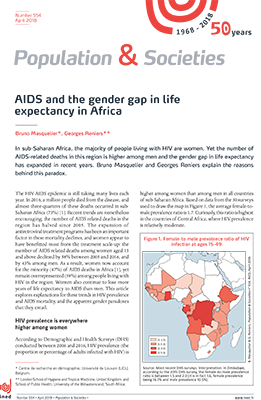AIDS and the gender gap in life expectancy in Africa
Press release Published on 11 April 2018
Population & Societies no. 554 – April 2018

In sub-Saharan Africa, the majority of people living with HIV are women. Yet the number of AIDS-related deaths in this region is higher among men and the gender gap in life expectancy has expanded in recent years. Bruno Masquelier and Georges Reniers explain the reasons behind this paradox.
In sub-Saharan Africa, women account for 59% of people infected with HIV, but only 47% of HIV-related adult deaths. To understand why women are overrepresented in the HIV-infected population, differences between men and women must be considered in terms of the exposure to infected partners, susceptibility to infection, and survival after infection. The female life expectancy advantage, which contracted as the AIDS epidemic spread, is now increasing again since the roll-out of antiretroviral treatments. Women’s uptake of HIV diagnosis and care services is better than that of men. Thanks to the integration of antenatal and HIV care (under programmes for the prevention of mother-to-child transmission), women are more effectively engaged with HIV services, and HIV-positive women tend to begin treatment earlier and adhere more closely to the treatment regimens.
Authors: Bruno Masquelier and Georges Reniers








